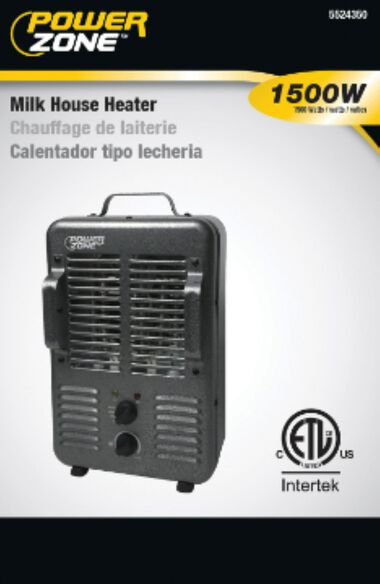A milkhouse heater is called so because it was designed to keep dairy barns warm in the winter. Originating for warming dairy barns, milkhouse heaters provide efficient heating solutions.
These heaters have a history of over fifty years and were initially used to maintain warmth in dairy structures during cold winters. The term “milkhouse” heater stems from its primary function to regulate temperatures in places like barns or sheds where milk was stored.
These heaters are known for their reliability and effectiveness in providing supplemental heat where needed. Milkhouse heaters offer a practical and economical way to ensure a comfortable environment in various settings, making them a popular choice for many heating needs.


Credit: www.acmetools.com
Origins Of Milkhouse Heater
Origins of Milkhouse Heater: Milkhouse heaters have a rich history, originating from the need to keep dairy barns warm in the winter.
Invention For Dairy Barns
Evolution For Household Use
Functionality And Features
Precise Temperature Control
A milkhouse heater is equipped with precise temperature control settings to ensure optimal heat output.
Efficient Space Heating
The heater efficiently warms up small spaces such as garages or workshops, providing targeted heating performance.
Safety Mechanisms
The milkhouse heater incorporates safety mechanisms including automatic overheat protection for secure usage.
Benefits And Applications
Garage And Workshop Heating
Milkhouse heaters are extensively used for garage and workshop heating due to their efficient performance and durability. They provide reliable warmth in these spaces, making them suitable for various industrial and DIY applications. The portable nature of these heaters allows them to be easily moved around, catering to specific heating needs in different areas of the garage or workshop.
Household Utility
Milkhouse heaters serve as a valuable household utility, offering supplemental heating for rooms that may lack proper insulation or central heating. They are particularly useful in areas that experience extreme cold weather conditions, providing an affordable and effective solution to maintain a comfortable indoor environment. These heaters are also suitable for heating smaller rooms, creating a cozy atmosphere during the colder months.
Affordability And Durability
One of the primary advantages of milkhouse heaters is their affordability and durability. They offer cost-effective heating solutions, making them accessible to a wide range of consumers. Additionally, their sturdy construction and longevity ensure long-term usage without frequent replacements, making them a sustainable heating option for both residential and commercial settings.
Energy Efficiency And Consumption
When it comes to energy efficiency and consumption, milkhouse heaters provide a cost-effective solution for heating small spaces such as garages, workshops, or barns. These heaters are specially designed to optimize electricity consumption and minimize energy waste, offering an eco-friendly heating option.
Electricity Consumption
Milkhouse heaters are known for their energy efficiency, consuming 1500-Watt of electricity. This wattage is ideal for localized heating and provides enough warmth for small areas without placing a significant burden on your electricity usage.
If we compare milkhouse heaters to other electric heaters such as infrared heaters or baseboard heaters, their electricity consumption is relatively similar. However, their design and heating performance make them stand out in terms of energy efficiency.
Energy-efficient Design
The design of milkhouse heaters contributes to their energy efficiency. These heaters are equipped with features that help optimize heat output and minimize energy waste. Some of the key design elements of milkhouse heaters include:
- Compact size: The compact size of milkhouse heaters allows for targeted heating, ensuring that the warmth is directed where it is needed the most.
- Thermostat control: Most milkhouse heaters come with adjustable thermostat controls, allowing you to set the desired temperature and avoid overheating the space.
- Fan-forced heating: Milkhouse heaters utilize a fan-forced heating mechanism that quickly distributes warm air throughout the room, reducing heating time and energy consumption.
- Overheat protection: These heaters are equipped with automatic overheat protection devices, ensuring safety and preventing energy waste in case of overheating.
Cost-effective Heating
One of the major advantages of milkhouse heaters is their cost-effectiveness. Their efficient energy consumption helps save you money on your heating bills by providing targeted heating performance where you need it the most. Additionally, their affordable price point makes them a budget-friendly option for small space heating.
If you’re looking for a reliable and energy-efficient heating solution, milkhouse heaters offer a great balance between performance and cost-effectiveness. With their efficient design and optimized energy consumption, these heaters can keep you warm while minimizing the impact on your electricity usage.
Consumer Reviews
A milkhouse heater is so named because it was initially designed to keep dairy barns warm during the winter. The term ‘milkhouse’ refers to a small structure used at dairies for keeping milk cold, and sometimes heated to prevent it from freezing.
These heaters have been around for more than fifty years and were originally intended for agricultural use.
Performance And Reliability
When it comes to performance and reliability, milkhouse heaters have received positive feedback from consumers. These heaters are designed to quickly and efficiently warm up small spaces, making them ideal for garages, workshops, or other enclosed areas. Users have reported that milkhouse heaters provide consistent heat and maintain the desired temperature effectively, even in colder climates. This reliability makes them a popular choice for those looking for a dependable heating solution.
Noise Levels And User Experience
One of the factors that consumers often consider when choosing a heater is the noise level. Milkhouse heaters are known for their quiet operation, allowing users to enjoy a peaceful environment without the disruption of loud fan noises or rattling sounds. Users have praised the noiseless performance of milkhouse heaters, making them suitable for use in bedrooms, offices, or any space where noise is a concern. In addition to low noise levels, users have also found milkhouse heaters to be user-friendly, with simple controls and easy-to-understand instructions.
Comparison With Other Heating Options
When compared to other heating options, milkhouse heaters offer several advantages. Firstly, their compact design allows for easy portability, making them suitable for use in various locations and easy to store when not in use. Milkhouse heaters also offer energy-efficient heating, which can help reduce heating bills while still providing effective warmth. Additionally, their versatility in heating small spaces makes them a cost-effective alternative to larger heating systems that may consume more electricity. Overall, milkhouse heaters have been well-received by consumers who value their performance, reliability, and energy efficiency.

Credit: www.acmetools.com

Credit: www.compass.com
Frequently Asked Questions For Why Is It Called A Milkhouse Heater
Why Is A Milkhouse Heater Called A Milkhouse Heater?
A milkhouse heater is called so because it was initially designed to keep dairy barns warm in winter.
How Safe Are Milkhouse Heaters?
Milkhouse heaters are safe as they are equipped with automatic overheat protection and ETL certification for safety.
Are Milkhouse Heaters Energy Efficient?
Milkhouse heaters are energy efficient and can help save on heating bills by providing targeted heating where needed.
How Much Electricity Does A Milk House Heater Use?
A milkhouse heater uses 1500 watts of electricity. These heaters were originally designed to keep dairy barns warm in the winter.
Why Is It Called A Milkhouse Heater?
The term “milkhouse heater” originated because these heaters were initially designed to keep dairy barns warm in the winter.
Conclusion
The term “milkhouse heater” originated from its initial use in dairy barns to maintain warmth during winter. Despite the change in application, the name has endured. Today, milkhouse heaters continue to provide efficient and targeted heating performance in enclosed spaces, embodying a historical legacy of practical utility.
